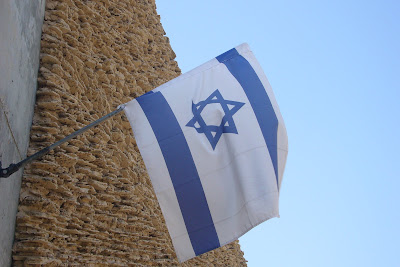

 The Tel Aviv beach scene.
The Tel Aviv beach scene. The Newburger family at sunset (Shabbat) overlooking the Mediterranean.
The Newburger family at sunset (Shabbat) overlooking the Mediterranean.


 The Tel Aviv beach scene.
The Tel Aviv beach scene. The Newburger family at sunset (Shabbat) overlooking the Mediterranean.
The Newburger family at sunset (Shabbat) overlooking the Mediterranean.

The Wexberg/Rothschild family above a waterfall.

Next we visited The Jaffa Institute, a social service agency in Jaffa/Tel Aviv serving poorer school children and their families. We helped with a mitzvah project and also visited one of their after school facilities and met some lively children!

Our group at The Jaffa Institute.

On our way to Tel Aviv, we took a few moments of reflection on an Old Jaffa hillside overlooking the Tel Aviv beach...let's get there already!
 The view of Tel Aviv from Old Jaffa.
The view of Tel Aviv from Old Jaffa. The Bonder family finds falafel at Jacky's on Ben Yehuda Street.
The Bonder family finds falafel at Jacky's on Ben Yehuda Street.
The Old City of Tzfat has many shops and historic synagogues.

The women pose in front of Falafel Queen.
We took a nature hike in Tel Dan, one of the headwaters of the Jordan River. This was similar to a hike in one of our Metroparks, but also very beautiful, oh, and surrounded by ruins from the Caananite period, the biblical period as worship center of the Dan tribe, and also from the Byzantine period. Pretty cool!

Our tour guide David Solomon at Tel Dan

 Military memorial on Mt. Bental.
Military memorial on Mt. Bental.Our touring day ended with a visit to the Golan Heights Winery, which was educational and fun. What happened after that is a little fuzzy...


Adam Bonder reverses the effects of a large earthquake on the ruins of Beit Shean.
Next we embarked on a family rafting trip down the “mighty” upper
A long drive up mountains took us to a kibbutz on the northern border with
United Nations observers keep an eye on our border meeting from the Lebanon border.
Our day ended visiting a Kabbalistic artist studio in the mystical city of Tzfat.
We had no trouble with the 4 am wakeup call on Monday morning to board the bus for the ride down winding roads to the desert floor, below sea level. It was hot, but not too hot, as we started the climb to
Restored ruins on top of Masada.
By now, we were hot as can be, so hiked up the Ein Gedi Nature Reserve to a lush waterfall to cool off.
Ein Gedi waterfall (above) is enjoyed by Ethan Newburger (below).
Our last stop in the desert was a dip in the
Serena Newburger floats in the Dead Sea.
We then took a long ride north through the Jordan River valley to the sister city of
The Newburger family enjoyed an interesting visit to a kibbutz family.

 Serena Newburger digs for ancient artifacts.
Serena Newburger digs for ancient artifacts. Ellen Halfon (above) and husband Rick Leibovich (below) climb through underground tunnels in the Maresha archaeological dig.
Ellen Halfon (above) and husband Rick Leibovich (below) climb through underground tunnels in the Maresha archaeological dig.
 Adina shows an image of a typical Ethiopian village. At left is our guide and transalor, David Solomon. At right is Rick Leibovich.
Adina shows an image of a typical Ethiopian village. At left is our guide and transalor, David Solomon. At right is Rick Leibovich.



